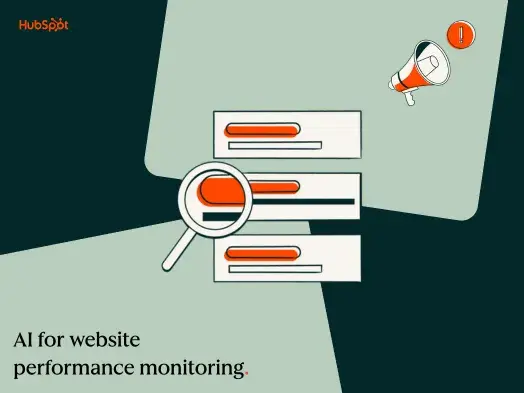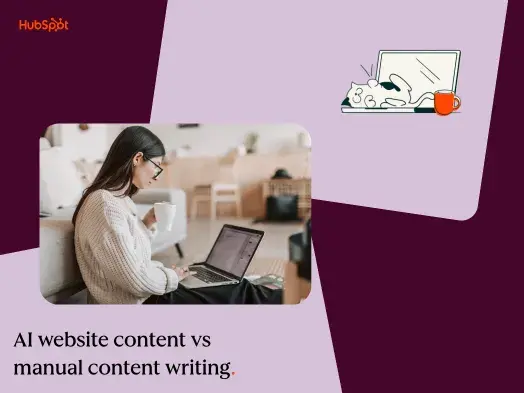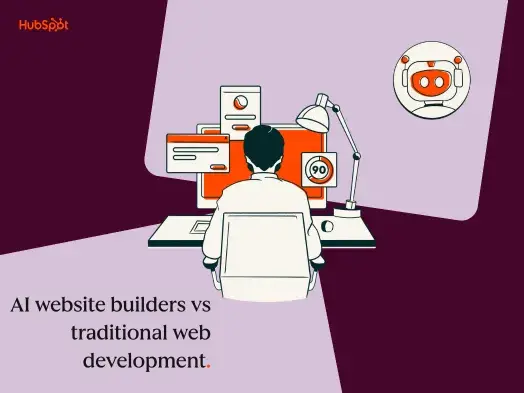But here‘s the thing: building this app meant I needed a bunch of apartment data. And who wants to spend hours copying and pasting info into a spreadsheet? Not me! That’s where Webscraper.io came in – it scraped data from a big multifamily company's website in the DFW, saving me a ton of time and giving me real apartment info to work with. This is just one example of how AI web scrapers can be helpful.
Whether you‘re building an app, researching something cool, or creating marketing campaigns, these tools can be your secret weapon for gathering real-time data. Don’t worry if you‘re new to scraping data. I’m here to break it all down for you.
Table of Contents
- What Is an AI Web Scraper?
- Benefits of Using an AI Web Scraper
- AI Web Scraping: Features to Look For
- Best AI Web Scrapers
What makes an AI web scraper different from a normal web scraper?
The primary goal of both AI web scrapers and traditional web scrapers is data extraction. However, they have different functionalities and use cases.
Traditional web scrapers rely on predefined rules and selectors (like CSS classes or IDs) to instruct the scraper on how to locate and extract data. However, they are often slower than AI web scrapers, may struggle to process JavaScript-heavy websites, and often require additional tools or manual adjustments to handle dynamic content or anti-scraping measures. This makes them less efficient and more user-dependent compared to AI web scrapers.
Let’s take a look at a real-world scenario comparing each method: Imagine you're building a price comparison tool for electronics. You aim to gather pricing data from multiple online retailers to offer consumers the best deals.
Challenge: The complexity of many ecommerce websites lies in their dynamic content. This means that product information is loaded asynchronously as users scroll or interact with the page, posing a significant challenge for traditional web scraping methods.
Limitation: A traditional scraper might need help to extract all product data, especially for websites with complex layouts or frequent updates.
Solution: An AI web scraper can more effectively handle dynamic content. It can analyze the website's structure and behavior, identify patterns, and extract the desired data even when loaded asynchronously.
Benefits of Using an AI Web Scraper
AI web scrapers can alleviate tasks for various roles, including data engineers, software engineers, or content managers. Since the technology is relatively new, it can be challenging to identify how it can benefit your workflow.
Here's a look at a few benefits of AI web scraping tools.
Enhanced Efficiency and Speed
AI web scrapers automate the data extraction process, significantly reducing the time and effort required compared to manual methods. This allows you to collect data faster and focus on analysis and insights.
I spoke to William Orgertrice |||, a data engineer at Tuff City Records, to hear his thoughts on the benefits of using web scrapers at work — particularly regarding increased efficiency.
Orgertrice noted, "Once AI web scraping tools came onto the market, I could complete […] tasks much faster and on a larger scale. Initially, I would have to clean the data manually, but with AI, this feature is automatically included in my workflow.”
Improved Data Accuracy
AI-powered tools can handle complex website structures and dynamic content more effectively, making your extracted data more accurate. This helps you avoid errors and inconsistencies in your data.
This lines up with Orgertrice’s experience, too: “When I worked at Global Payments, a Fortune 500 company and one of the largest payment processors in the world, I used web scraping tools to assist with automated quality assurance testing and test-driven development for projects that impacted millions of people daily [...] These tools and testing ensured the success and quality of credit and debit card transactions worldwide.”
Reduced Cost
AI web scrapers can save you time and resources by automating data extraction. In the long run, this can lead to a more efficient workflow that requires less human interaction.
Each role may have unique use cases, so it's important to research the tool and understand how it can be applied to your specific tasks.
AI Web Scraping: Features to Look For
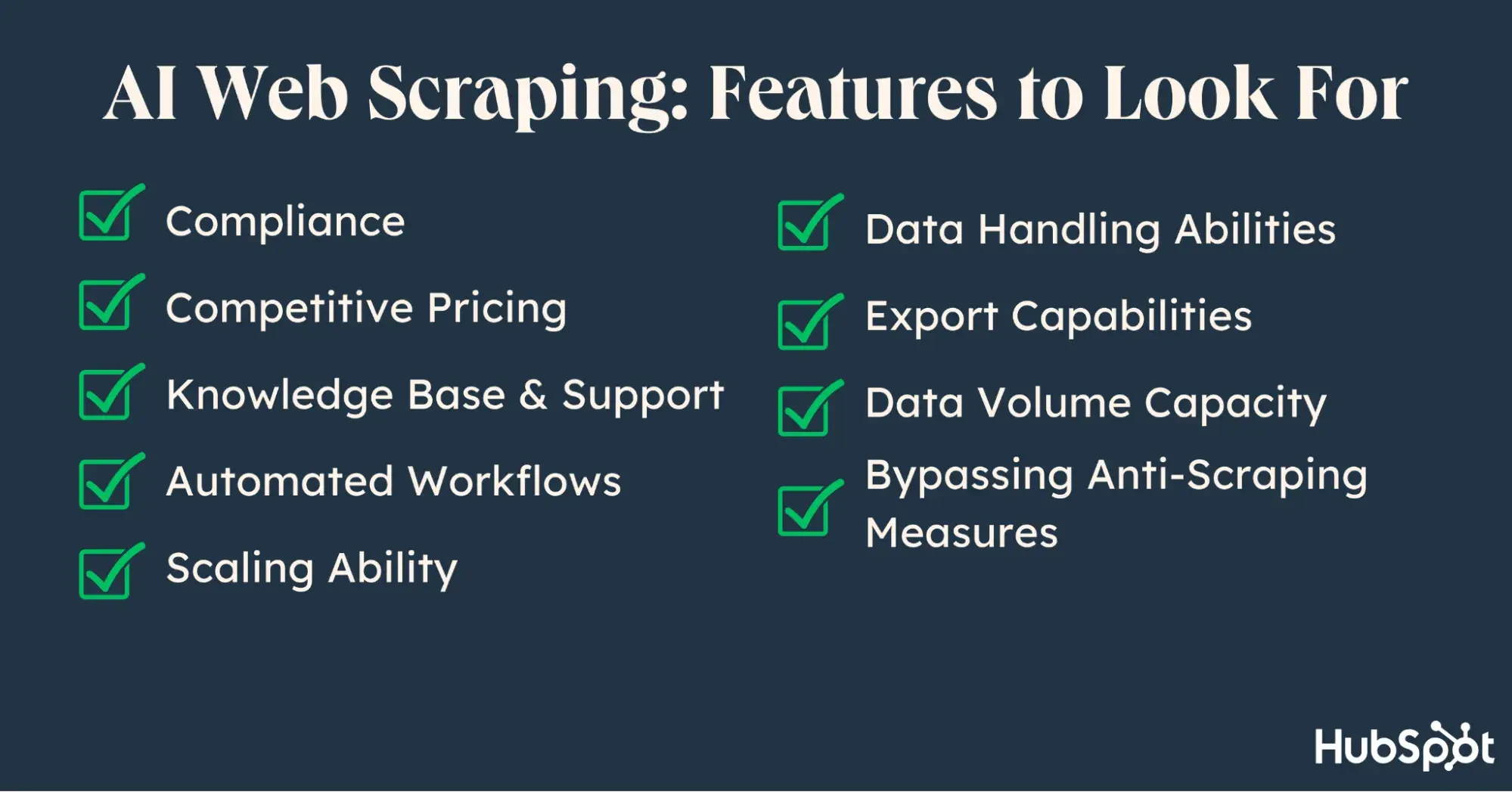
Compliance
Although web scraping is legal, the AI web scraping tool you choose must comply with relevant laws and regulations, such as GDPR and CCPA. I always strive to use data ethically and fairly. I recommend you look for tools that prioritize data privacy and security and offer features to help you comply with data protection requirements.
Competitive Pricing
When choosing an AI web scraping tool, pricing is always at the top of my list. Different tools offer various pricing models, such as subscription-based plans, pay-as-you-go options, or one-time fees. Evaluate your budget and the scale of your data extraction needs to determine the most suitable pricing model.
Additionally, consider if the tool offers any free trials or limited plans to help you assess its value before committing to a full subscription. Remember that free plans may not provide the features you need, and investing in a paid plan may be the way to go.
Knowledge Base and Support
A good knowledge base and support system are essential for a smooth user experience. Look for tools that provide comprehensive documentation, tutorials, and FAQs to help you get started and troubleshoot any issues. Tools like Browse.AI and Octuparse offer demos with their teams. This may be a good feature to prioritize if your team needs a hands-on tutorial before investing in a tool. Additionally, consider the availability of customer support, such as live chat or email, to assist you with any questions or problems.
Automated Workflows
Automated workflows can significantly improve efficiency and reduce manual effort. Look for tools that offer features like scheduling tasks, creating custom workflows, and integrating with other tools in your tech stack. Automated workflows can help you streamline your data extraction process and save time.
Scaling Ability
If your data extraction needs are likely to grow in the future, ensure that the tool you choose can scale to accommodate your increasing requirements. Consider factors such as the tool's ability to handle large volumes of data, its performance under heavy load, and its scalability options, such as using cloud technologies or automated workflows.
Data Handling Abilities
Evaluate the tool's capabilities for handling different types of data, such as structured data like tables and unstructured data like text or images. Consider whether the tool offers features for data cleaning, formatting, and transformation to prepare the extracted data for analysis or further processing.
Export Capabilities
Assess the tool's export capabilities compared to your project needs. Several tools have differing export options, so finding the perfect fit shouldn’t be an issue. Common export formats include CSV, JSON, and XML. I’ve even discovered that some tools let you export data directly to your application.
Data Volume Capacity
Ask yourself: what’s the volume of data that you need to extract? Is it small or large? This is important to know upfront because some tools may have limitations on the amount of data that can be extracted per month or per project. Double-check that the tool you choose can handle the required data volume. Spending time and money on a tool that can’t handle your project needs would be awful.
Bypassing Anti-Scraping Measures
Many websites implement anti-scraping measures to protect their data. Look for a tool that can effectively bypass these measures, such as handling CAPTCHAs, rotating proxies, or using advanced techniques to mimic human behavior.
Best AI Web Scrapers
Now that you understand the advantages of AI web scrapers over traditional ones, let's explore some tools to meet your data scraping needs.
To save you time, I've compiled a list of popular AI web scraping tools, highlighting their key features, pricing, and my personal experiences.
1. Octoparse
Best for: Beginners who need a no-code tool to extract data from sites like Google, Linkedin, Tiktok, and many more.
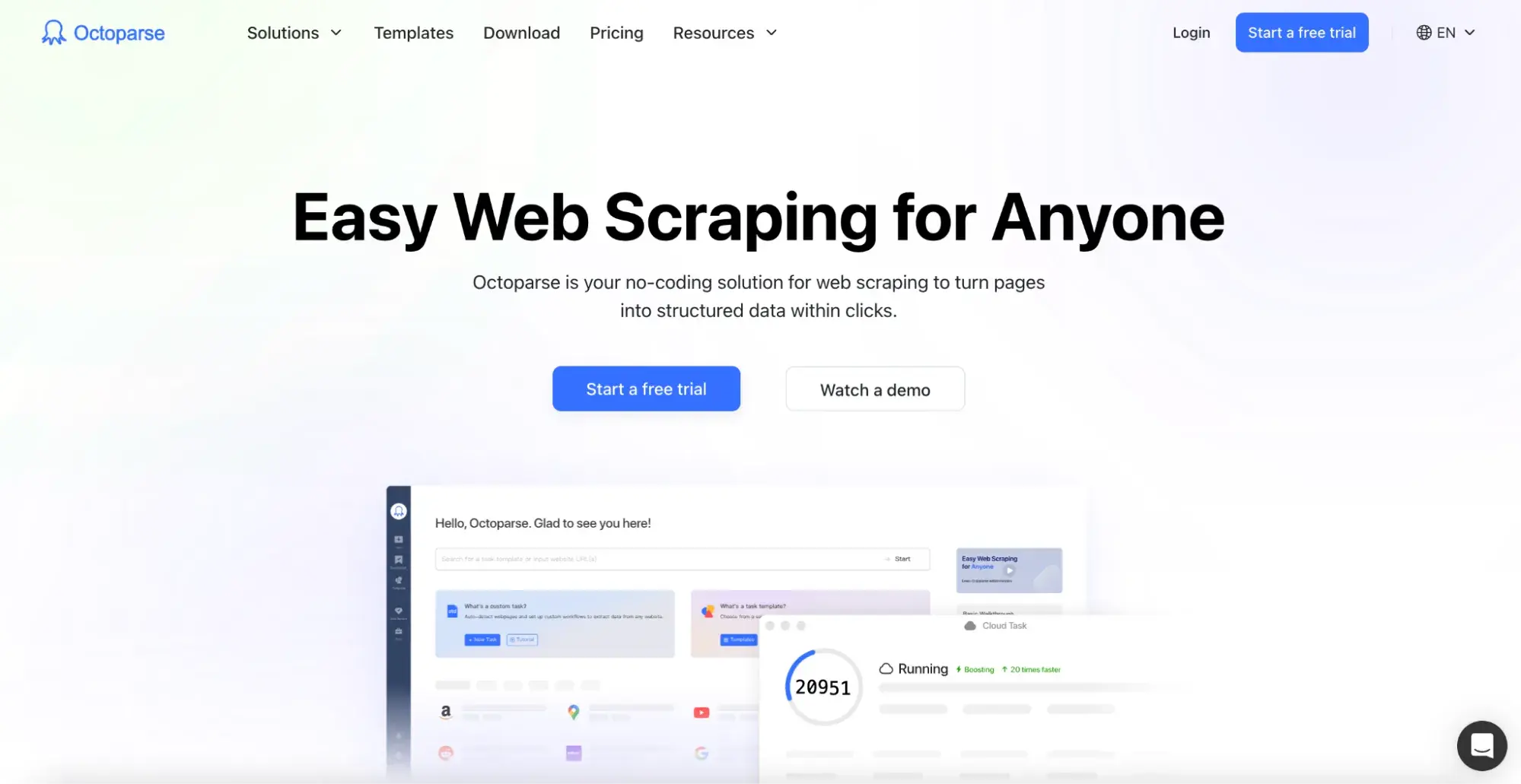
Octoparse is a beginner-friendly tool for extracting data from any website. To get started, I downloaded their desktop app to my computer. The app is only compatible with Windows or Mac. Once the download was complete, I signed up for the free trial and was quickly redirected to my Dashboard.
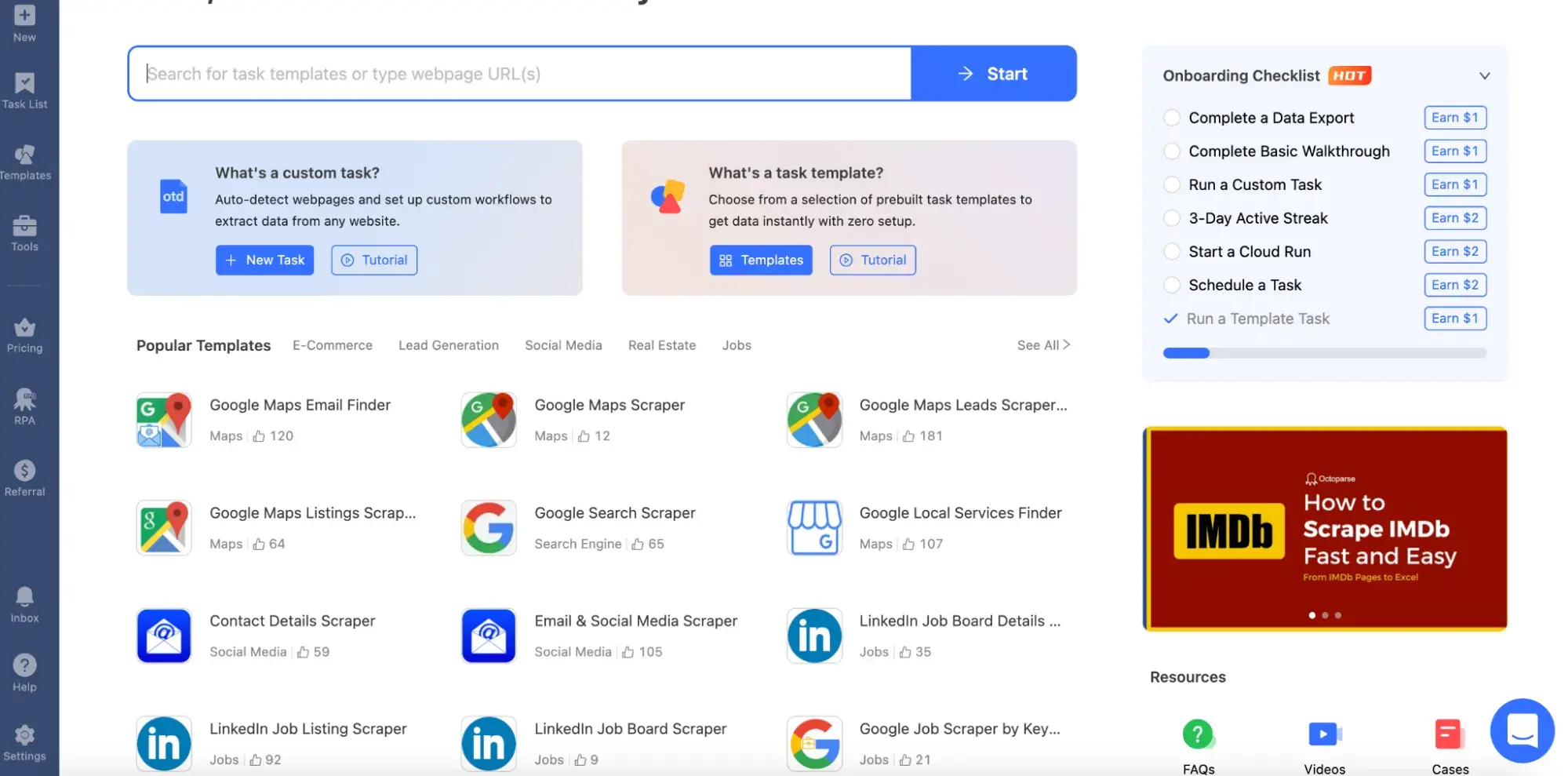
Thanks to their templates, running my first scrape was really simple. I used the Indeed template to extract the data from a job search for software engineer roles in Dallas, TX.
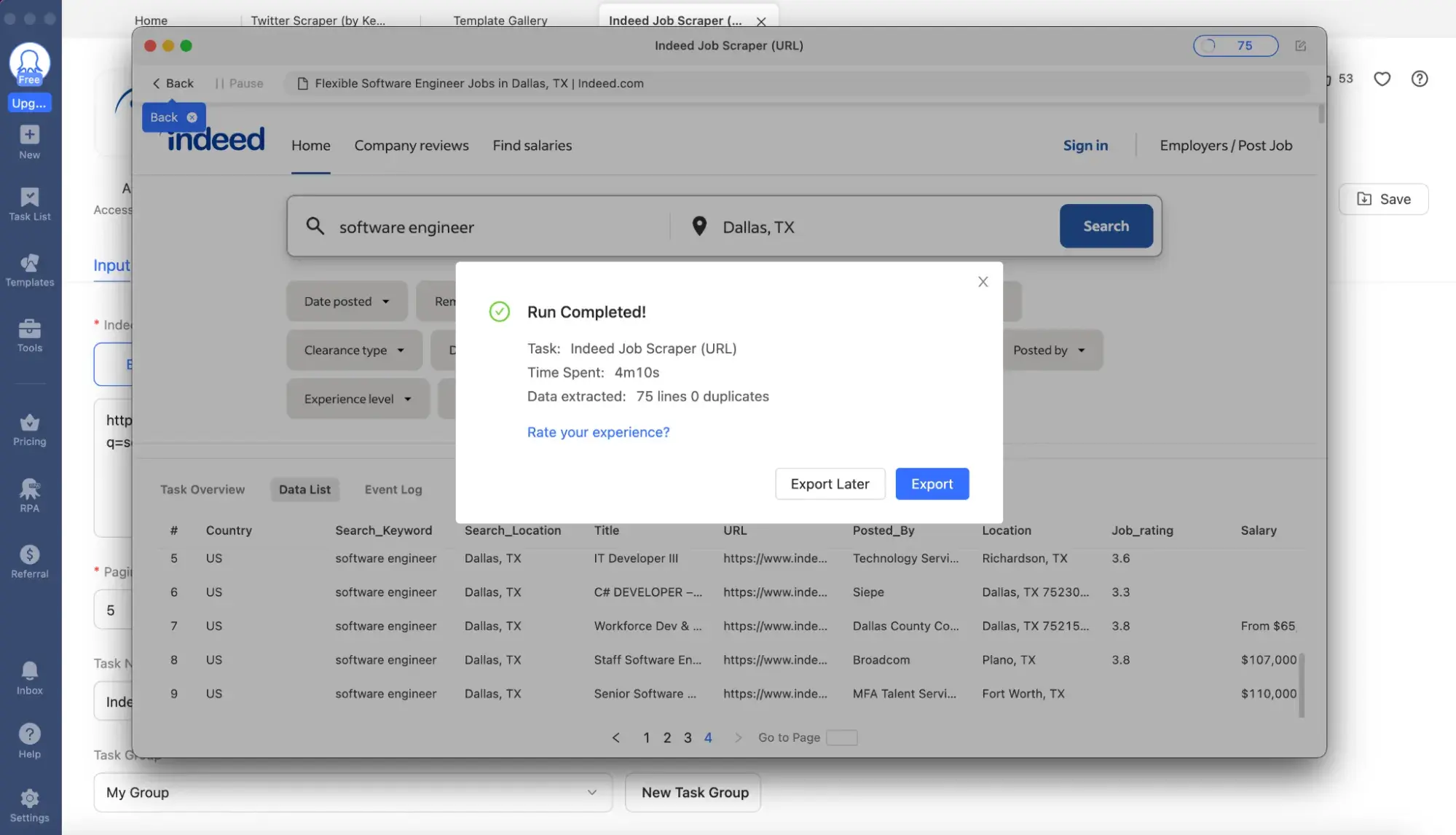
If you don’t see the template you need, you can copy and paste the URL of the website from which you want to extract data in the app's address bar and click “Start.”
What I like:
- It took me less than 5 minutes to figure out how to use the tool, from signing up to running my first extraction.
- Hundreds of premade templates for sites like Google, Twitter, Linkedin, and many more make this tool very user-friendly.
- You can easily export the data to other tools such as Google Sheets, Dropbox, Airtable, etc.
- The tool has a hybrid model, meaning you can run it locally or on the cloud.
Price: They have a free plan to test the tool before investing your money. Keep in mind that you will need to upgrade to a standard plan for $99 if you want to export data and access premium templates. Additionally, there’s a professional plan for $249 if you wish to access cloud processes and a higher task limit. Contact their customer service to inquire about pricing if you need an Enterprise plan.
2. ScrapeStorm
Best for: Those looking to extract data from webpages with tough anti-crawling mechanisms.
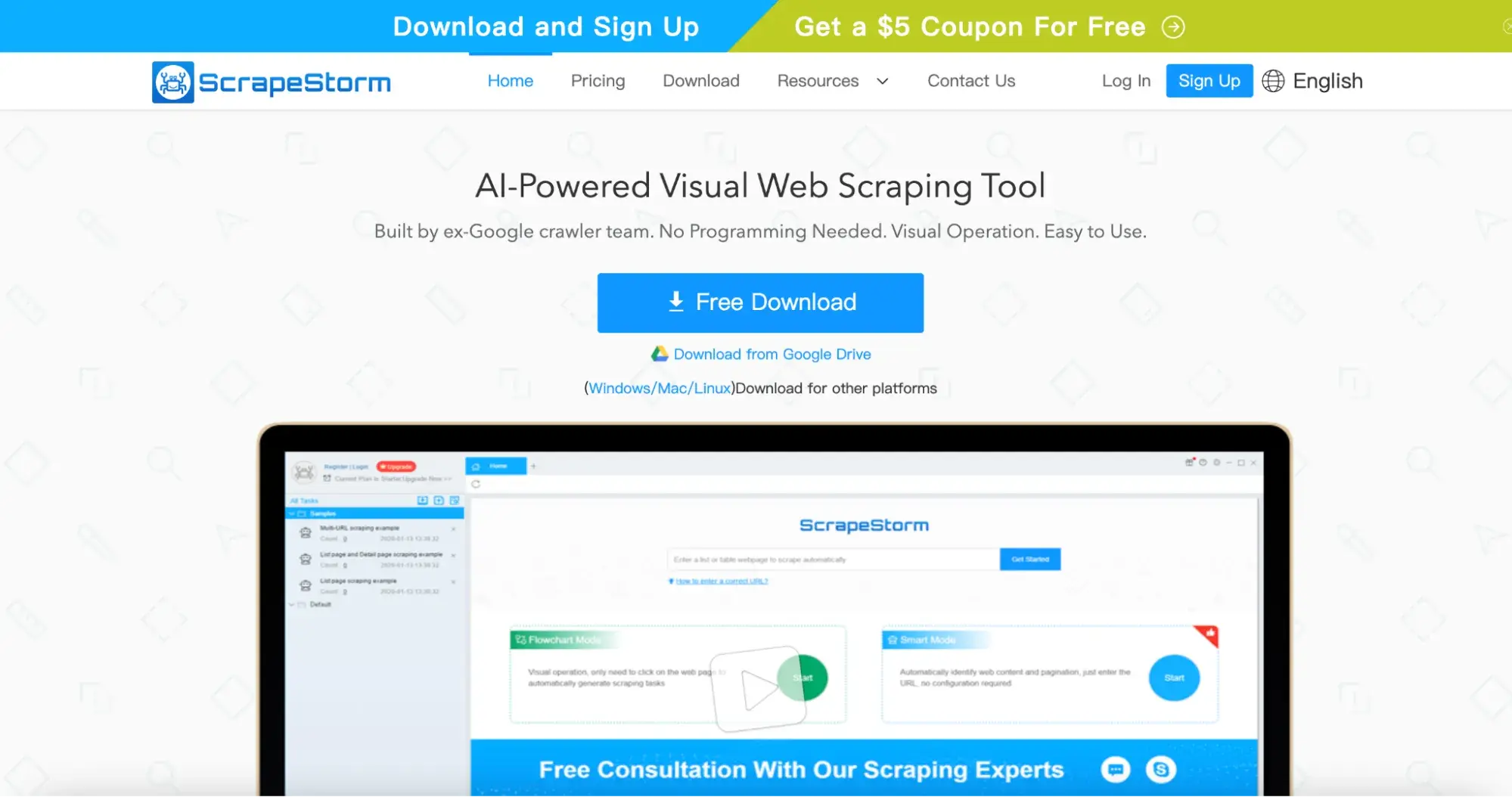
What I like about ScrapeStorm is its features, which cater to beginners and seasoned professionals, making it a well-rounded tool. The app can be downloaded by users of Windows, Mac, or Linux systems.
The tool offers two modes. With Smart Mode, users simply input the website's URL, and ScrapeStorm automatically identifies and extracts relevant data. This makes it easy for beginners to get started with web scraping.
The Flowchart Mode, on the other hand, is for more advanced tasks. Users can visually create a flowchart to define the scraping process, including steps like navigating to specific pages, extracting data, and handling dynamic content. This mode is ideal for complex scraping tasks or users who prefer a more hands-on approach.
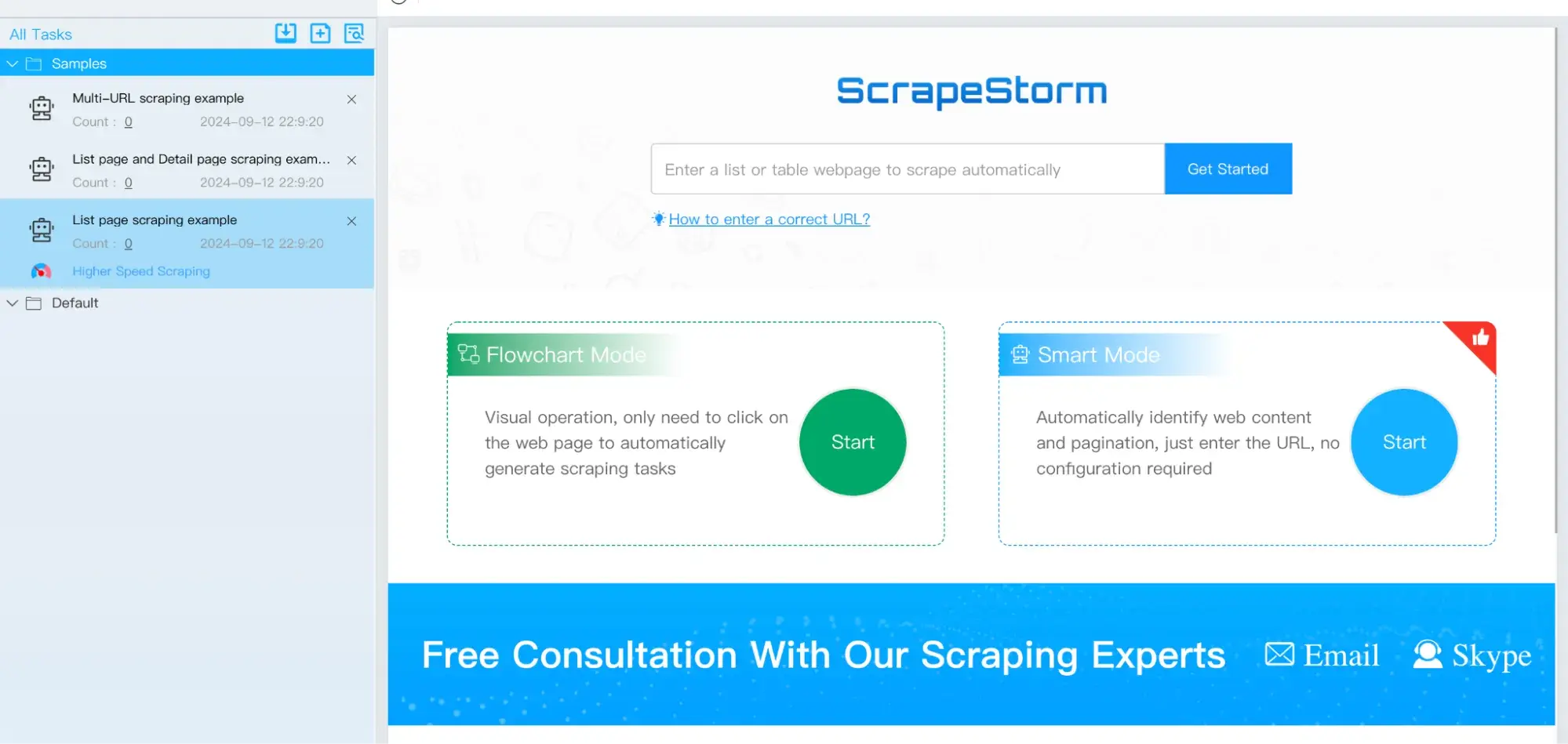
What I like:
- You can export data to websites or databases like MySQL, WordPress, or MongoDB.
- You can export data on their free starter plan, unlike other tools.
- There’s only a cloud option, but all your tasks are automatically saved, preventing data loss.
- They offer the option to export data to your computer locally or to the cloud.
Price: ScrapeStorm offers more reasonable prices compared to other AI scraping tools. There’s a free starter plan that doesn’t require a credit card to use. If you need access to more features, upgrade to their Professional plan for $49.99 or Premium for $99.99. Enterprise customers can purchase a business plan for $199.99 or contact their team for a customized plan and price.
3. ExtractAI
Best for: Developers and businesses that need a reliable tool to sync, filter, and extract structured data from email inboxes automatically.
ExtractAI is a powerful tool designed for automating the extraction of structured data from emails. Built with advanced machine learning (ML), natural language processing (NLP), and large language models (LLMs), it simplifies complex workflows by transforming unstructured email data into actionable insights.
To get started, developers can easily integrate ExtractAI into their applications with minimal code. It doesn't require email forwarding, ensuring secure and real-time synchronization directly from users' inboxes.
What I like:
- ExtractAI supports tens of thousands of global merchants, so you can trust it to extract data precisely—even from a wide range of emails like receipts, invoices, and shipping updates from over 30,000 merchants.
- It offers up to 92% cost savings compared to traditional AI solutions.
- Developers can quickly integrate it into their apps, making it easy to create personalized user experiences and automated workflows.
- Data stays up-to-date and is securely extracted – no manual work is required.
Price: ExtractAI is available with a free Nylas sandbox account and is charged per successfully extracted email. Pricing depends on volume commitments and your specific business needs.
4. Browse AI
Best for: Projects that need extracted data to be updated on a set schedule.
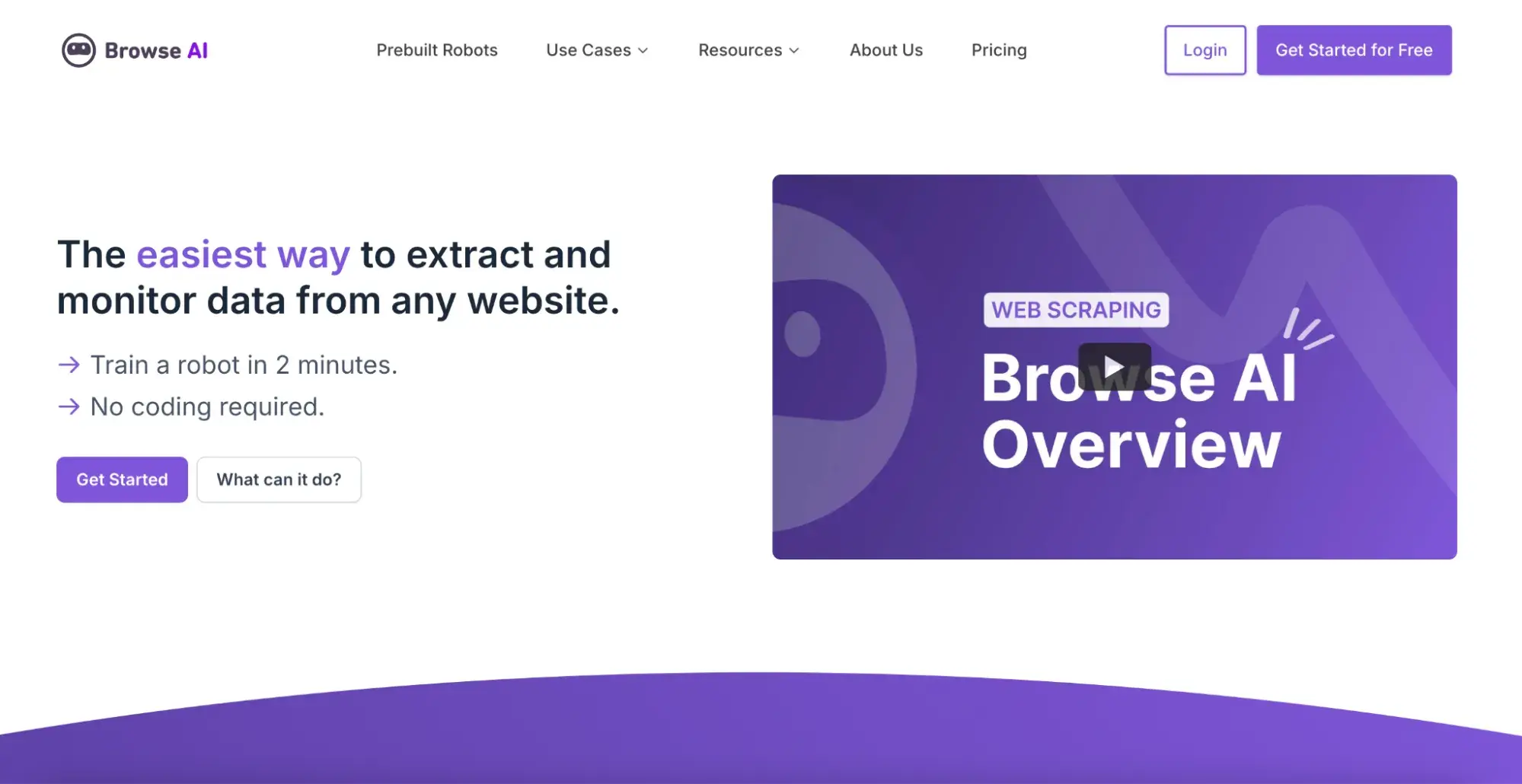
Like Octoparse, Browse AI is a user-friendly tool that can extract data from any website with a URL. One of its standout features is the simplicity of creating spreadsheets from extracted data. I input the target URL, specify whether I am extracting a table or text, name my spreadsheet headers, and that’s it.
Additionally, Browse AI offers scheduled data extraction, making it ideal for projects involving time-sensitive or frequently updated information, such as stock prices, sales campaigns, or social media posts.
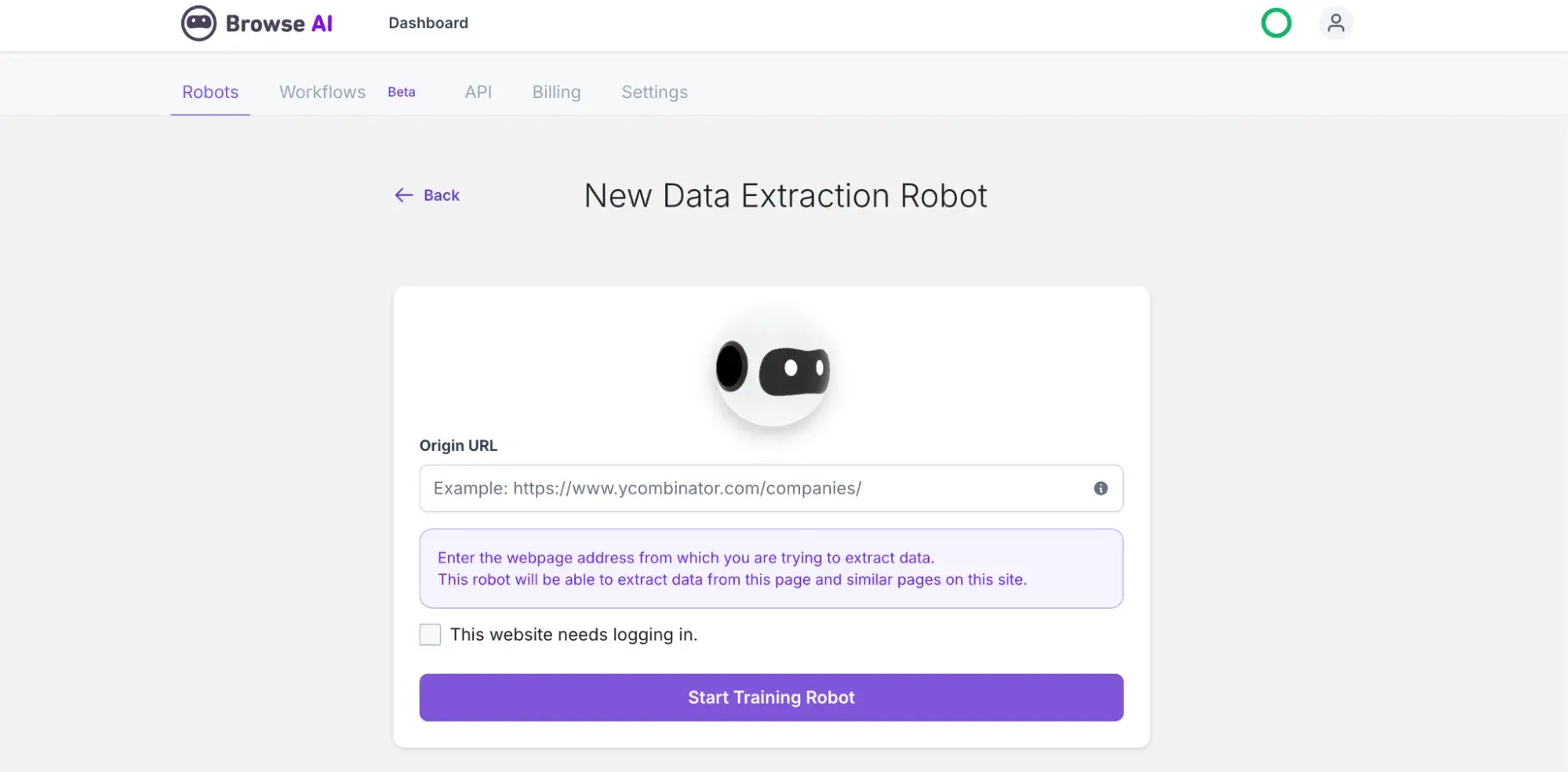
What I like:
- The comprehensive knowledge base and video tutorials were easy to follow.
- You can connect two robots and train them to extract deep data for more detailed data results.
- Their bulk run feature allows you to extract data across multiple URLs.
- You can start by using the tool from your browser. No downloads are necessary.
Price: With their free plan, you can start with 50 credits per month. If you want more credits, robots, and shorter update times, you can check out their Starter ($19), Professional ($99), or Team ($249) plans.
5. Apify
Best for: Developers and teams that need scalable web automation and custom data extraction..
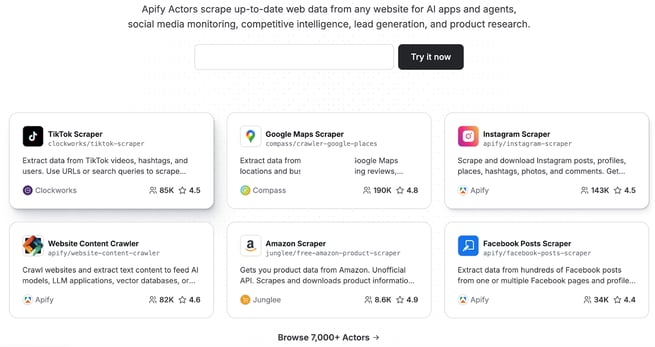
Apify is a powerful web scraping and automation platform built for developers and enterprises. It’s great for collecting, transforming, and integrating web data at scale. You can build custom scrapers, automate workflows, or use pre-built “actors” from the Apify Store — all hosted in the cloud.
What sets Apify apart is its flexibility. It offers both no-code templates for quick setup and a developer-friendly SDK for advanced use. You can schedule scrapers, handle CAPTCHA, rotate proxies, and export data straight to Google Sheets, Airtable, or your own app.
What I like:
- Thousands of ready-to-use scrapers for sites like Amazon, TikTok, Instagram, and LinkedIn.
- Scales automatically in the cloud with proxy rotation and smart retries.
- Excellent documentation and a large open-source community.
Pricing: Apify offers $5 in free credit to get started, letting you test any actor before committing. Paid plans start at $49 per month, with options for higher workloads and enterprise features.
6. Bardeen Scraper
Best for: Projects that need a tool with web scraping and API development capabilities.
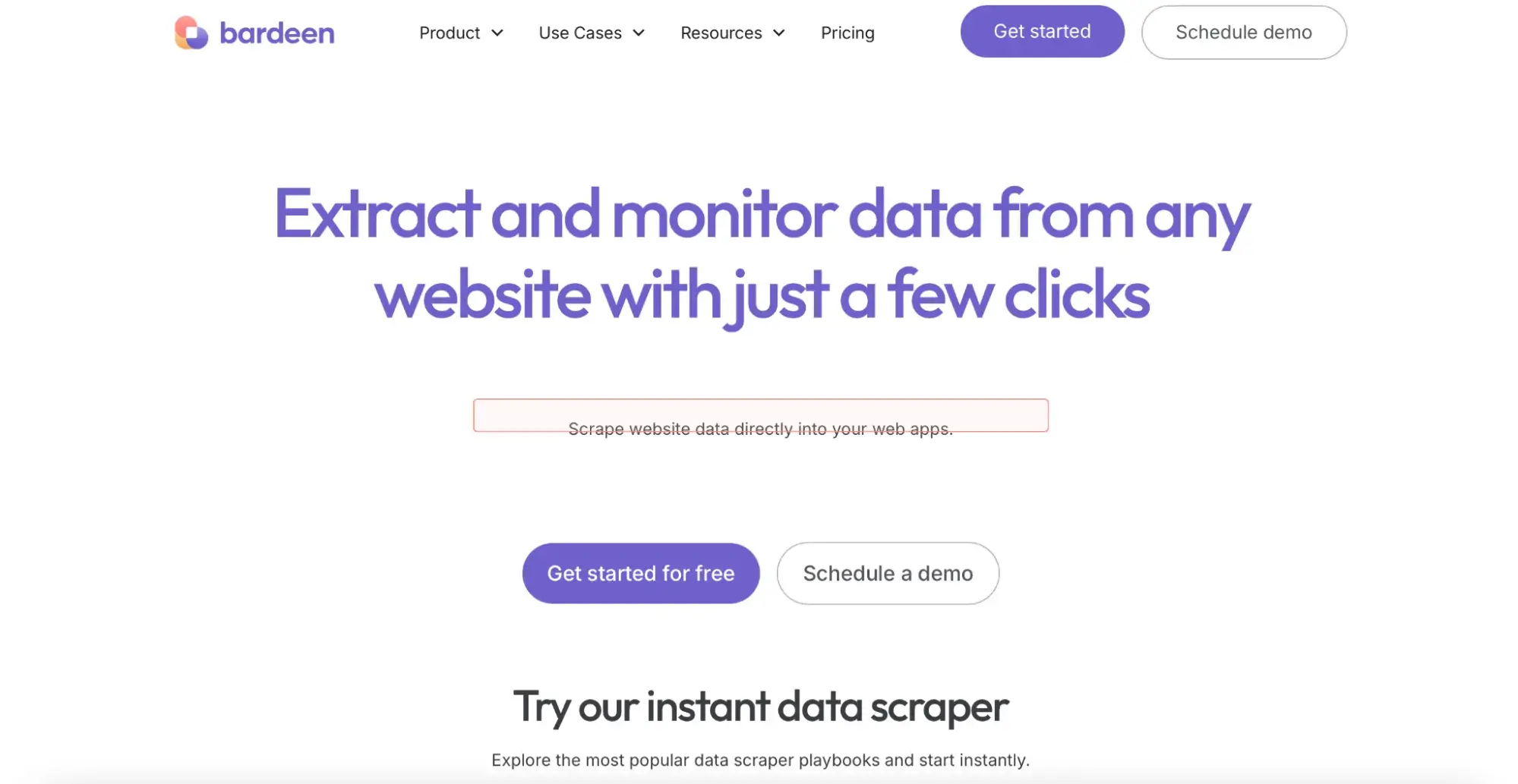
Whether your role is in sales, recruiting, or market research, the Bardeen Scraper can adapt to your needs. While the tool can be used for web scraping, its functionality beyond that makes it an excellent choice. One-click allows you to filter, fill, and export the needed data.
Additionally, you can use your new AI best friend to draft emails, fill out forms, and automate everyday tasks. This tool is perfect for repetitively extracting data from a single source.
What I like:
- A multifaceted tool built for many different projects thanks to its ability to integrate with hundreds of apps like TikTok, Slack, Crunchbase, and many more.
- It has a supportive community that includes a YouTube channel, knowledge base, and user forum.
- It can incorporate AI into your spreadsheet, making data extraction and analysis more powerful and comprehensive.
Pricing: While Bardeen does have a free plan, it doesn’t include an AI web scraper. To take advantage of their AI helper, you must sign up for their pro plan, which starts at $10 monthly. There’s also a Business plan option for $199 and an Enterprise plan with custom pricing.
7. ScrapingBee
Best for: Seasoned developers looking to customize JavaScript to simulate webpage interactions while scraping for data.
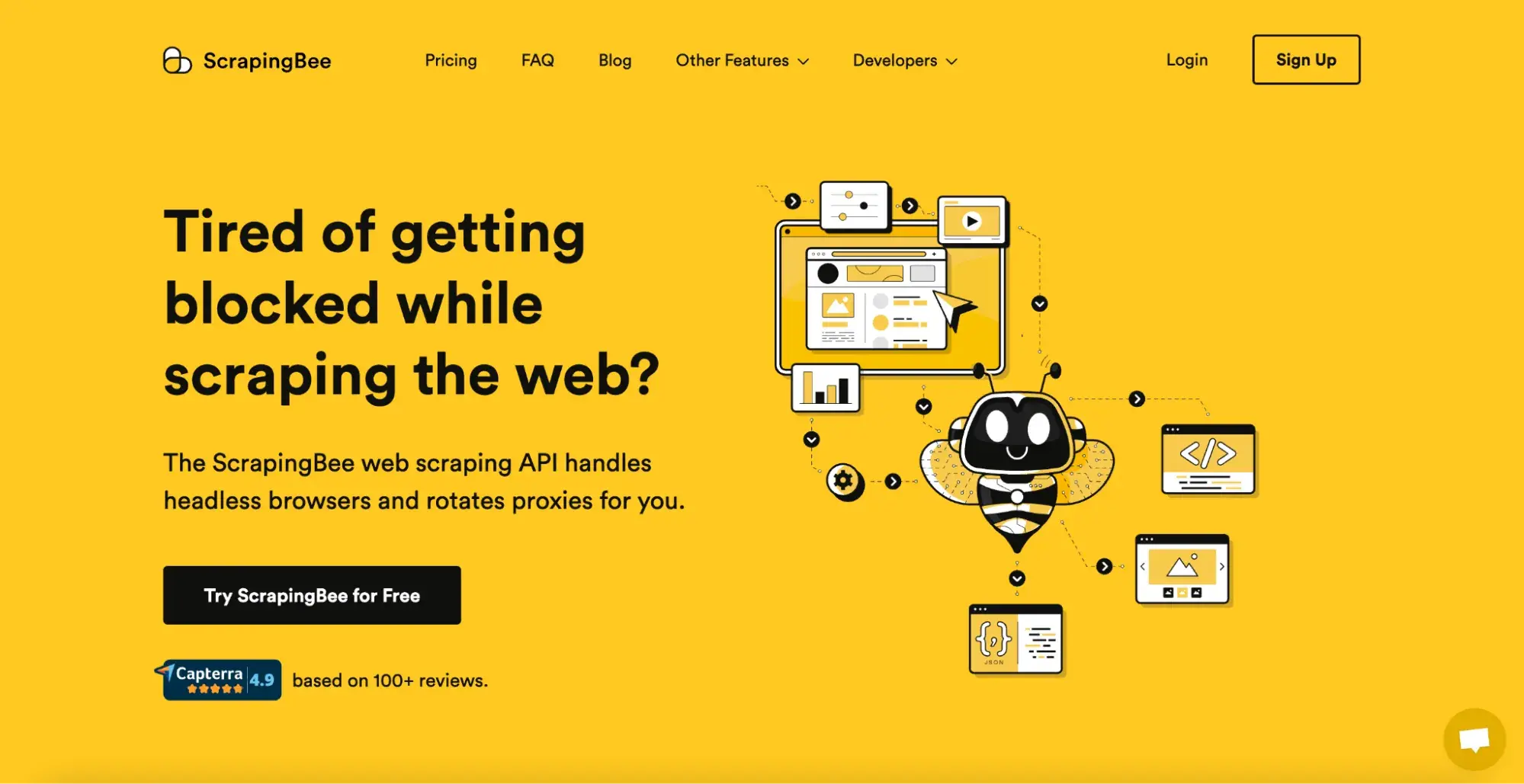
ScrapingBee is not as beginner-friendly as some of the other tools. I recommend that users know about APIs before investing in this tool. Nonetheless, it is still an excellent AI web scraping solution.
Since the tool extracts HTML with an API call, the first step is notating the provided API key. Next, you will use the curl command along with your API key and the URL of the page you want to extract data from. What I like the most about ScrapingBee is that it gives you starter code to make an API call in different program languages like Jave, Node.js, etc.
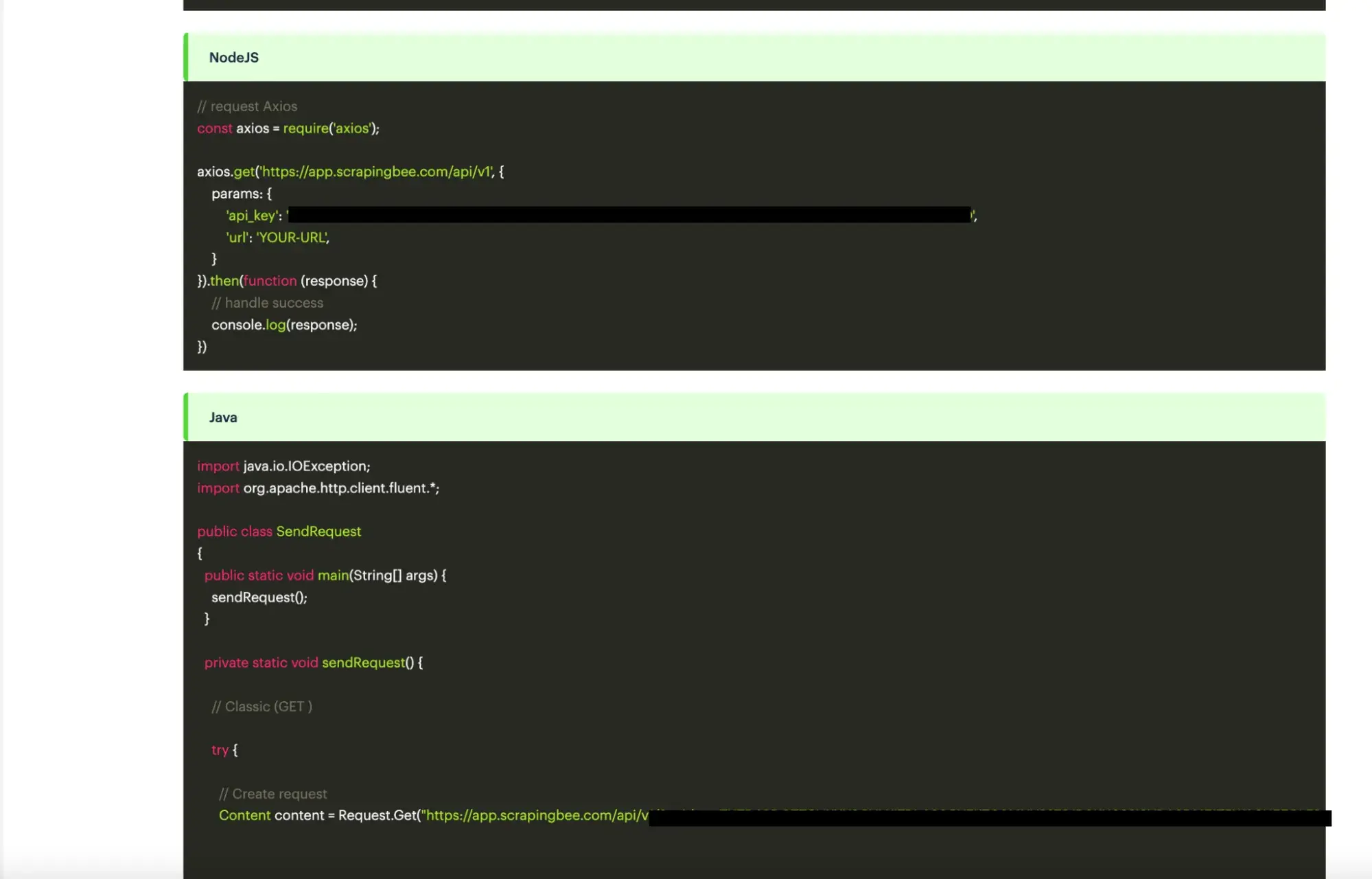
What I like:
- Highly customizable in various program languages.
- Provides a log and analytics report showcasing your data extraction activities.
- Leverages Axios and other API call libraries to effectively retrieve data from web sources.
8. Import.io
Best for: Large enterprise teams with high-volume data extraction needs.
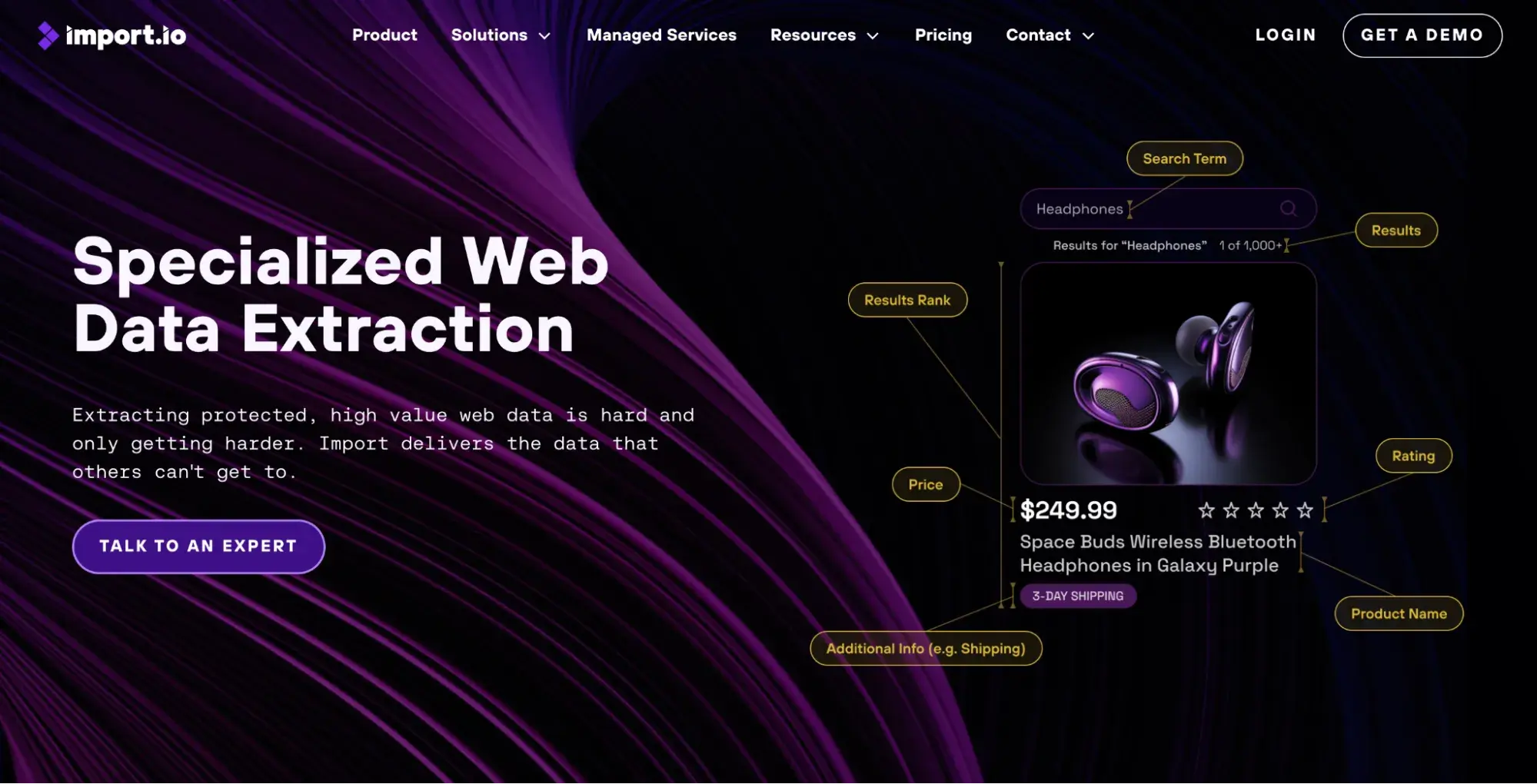
Import.io prides itself on making data extraction a five-minute or less task to set up. To get started, you simply enter your target URL, train the extractor by specifying the data points you are interested in, and name the columns of your list. Extracting data using this tool is just as simple as that.
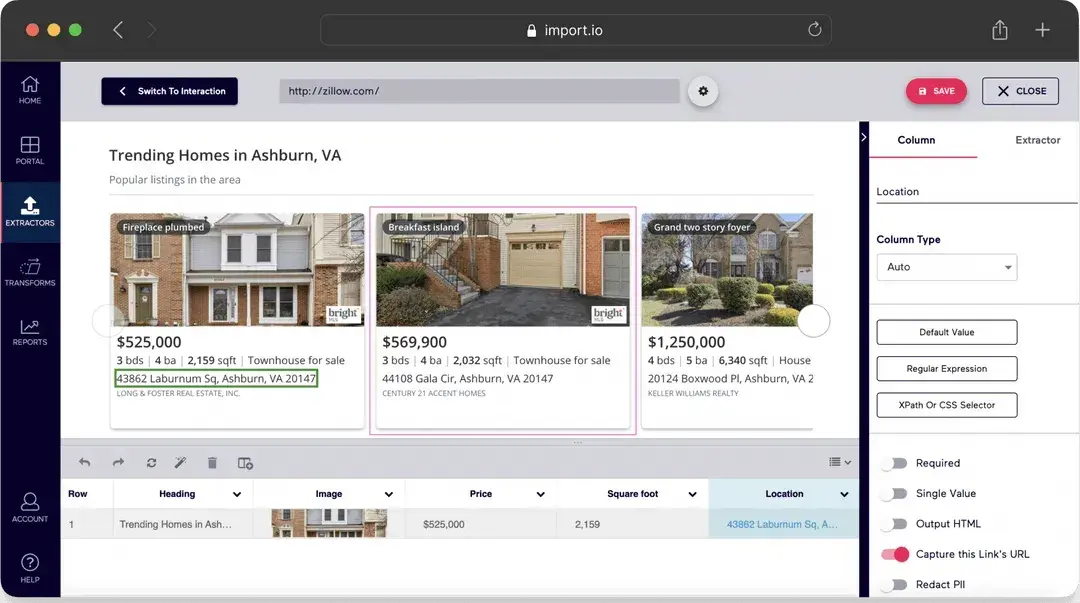
If you want to retrieve data using multiple URLs, they have a chaining option that does the heavy lifting, eliminating the need to manually enter each URL.
What I like:
- This tool has a beginner-friendly UI that can be quickly followed without much confusion.
- Import.io allows screenshots to be captured alongside the extracted data for enhanced traceability. This can help verify the source and context of the extracted information.
- Its use of machine learning makes it easy to train your extractor, and it gives suggestions as you click through your target source for data extraction.
Pricing: Import.io's pricing structure may not be ideal for smaller projects due to its higher starting point than other AI web scraping tools. It does not offer a free plan, with its entry-level “Starter” option priced at $399 monthly.
To access anti-web scraping methods, users must upgrade to the “Standard” plan, which starts at $599 monthly and appears to be their most popular option. Import.io also offers an “Advanced” plan with additional features for $1099 per month.
9. Parsehub

If you want to avoid a browser-based scraping tool, consider Parsehub. I could easily download the client on my Mac, and Linux and Windows users can do the same.
After downloading, I begin my project by entering the URL of my target website, Macy‘s. ParseHub then analyzed the page’s structure and gave me options for selecting the desired data elements I was interested in.
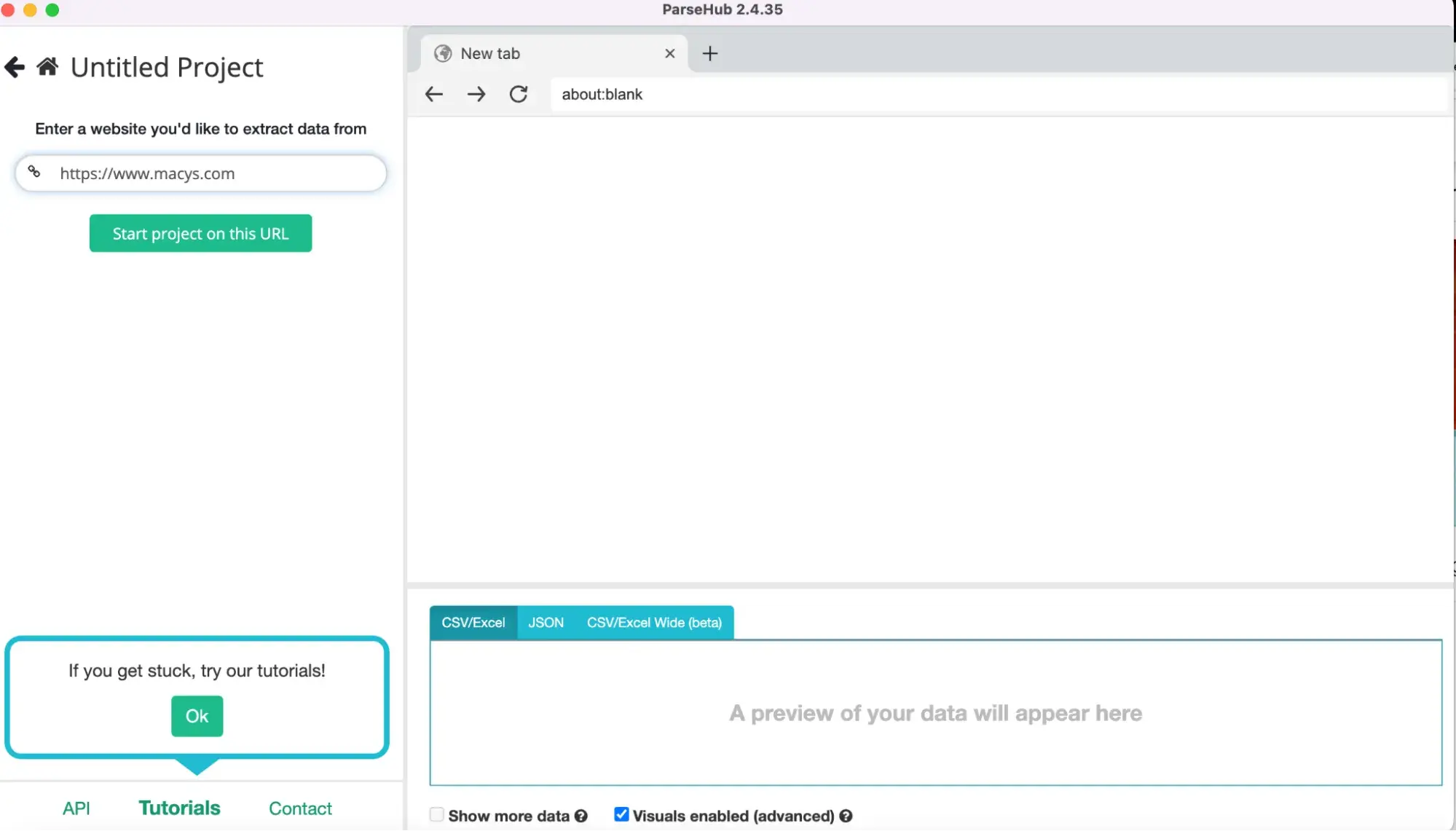
By clicking on these elements, I teach ParseHub to identify and extract relevant information. Once I define the extraction process, I can schedule automatic jobs with ParseHub to collect data regularly. The extracted data can then be exported in various formats, such as CSV, JSON, or Excel, for further analysis or application use.

What I like:
- They offer blogs that give a detailed analysis of their use cases using major brands.
- If you want to add visualization to your data, the tool integrates with Tableau and Plug Data.
- Works great with large data extraction projects thanks to the ability to collect millions of data points.
Price: ParseHub offers a free option, requiring no credit card. While slower and limited to 200 pages per run, it's a good starting point. The standard option, priced at $189 per month, also offers 200 pages with a faster extraction speed of 10 minutes. For unlimited pages and extraction speeds under 2 minutes, the professional option is available for $599 per month. If you require more customized features, consider contacting ParseHub to discuss their Enterprise plan.
9. Kadoa
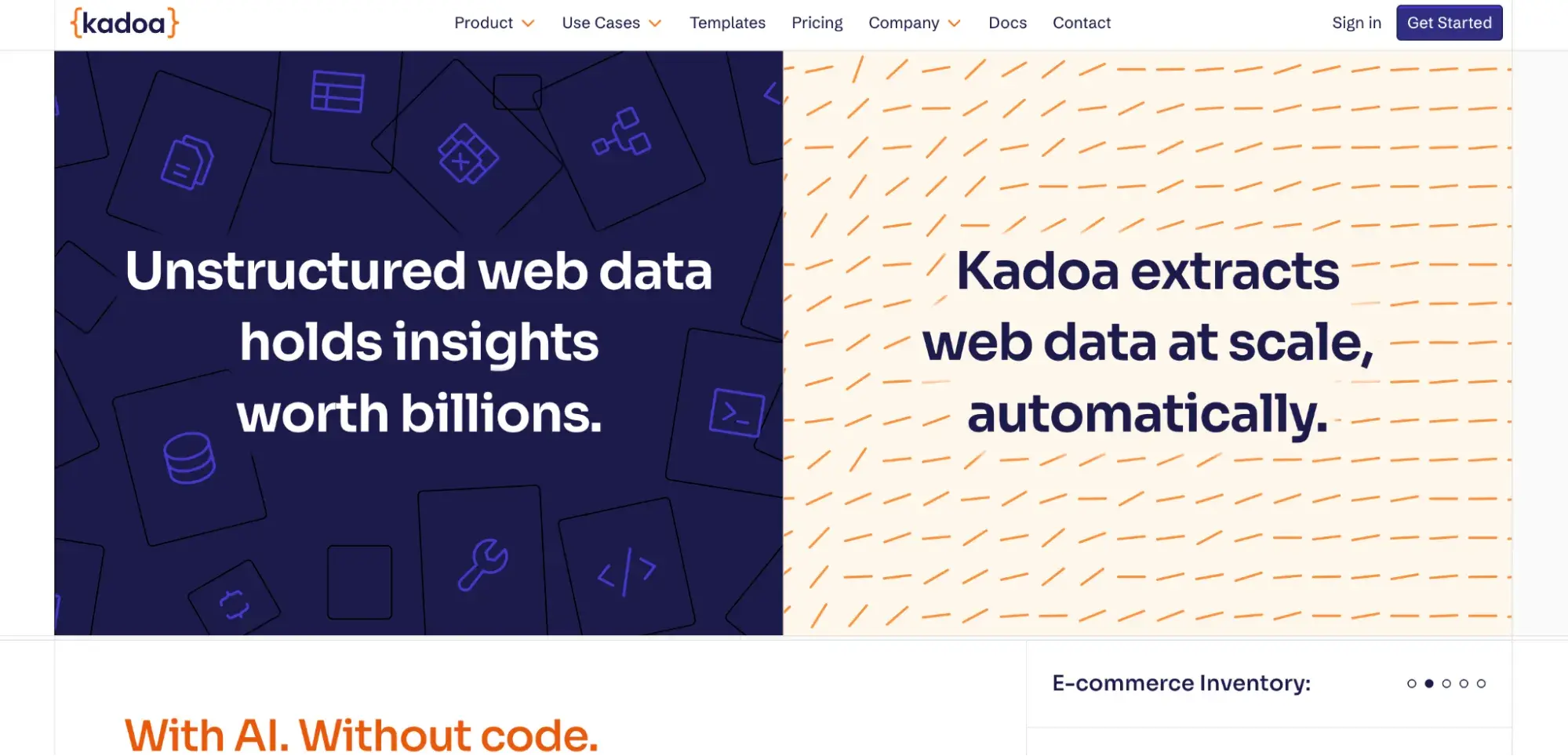
Kadoa is an AI web scraper that allows users to scrape and quickly clean unstructured web data. The software is beginner-friendly with its no-code option and ready-to-use templates. Thanks to its monitoring features, it works excellently for finance, ecommerce, or job postings. Kadoa also offers comprehensive use case guides to help you get started today.
What I Like:
- Kadoa offers data cleansing, which saves time and money.
- I love their data monitoring, which alerts me if data changes on my target source.
- Their notification options keep you in the loop of what’s happening in your workflow.
Pricing: Kadoa offers a free tier with 500 credits, but this option is limited. For $39 a month, use their self-service option for more credits and integrations. For Enterprise options, reach out to their team for custom options.
Data Extraction Needs AI
Incorporating AI with data extraction tools has significantly simplified the data collection process. Unlike traditional methods, AI tools offer a more user-friendly experience. However, there's no single one-size-fits-all solution. Each tool has unique features, increasing your chances of finding one that caters to your needs. My favorite option is Browse.ai. Being able to train multiple “bots” to handle data extraction from various URLs stole the show for me.
Regardless of your chosen tool, understanding your project requirements is essential. A clear picture of your needs allows you to select software with the most relevant features, optimizing your workflow for seamless automation. Remember, choosing the right tool can significantly enhance your data extraction experience.
Artificial Intelligence


.png)
